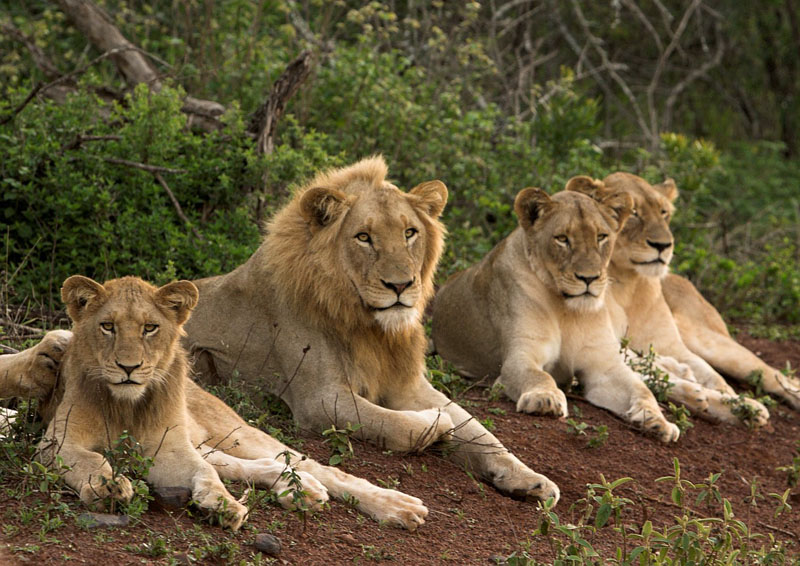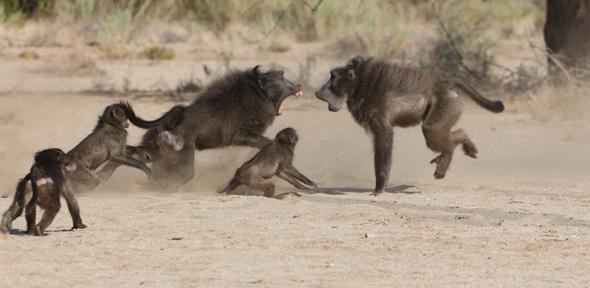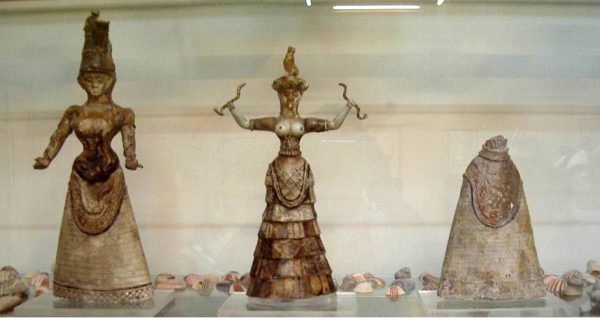In all scientific fields, prejudices can affect the perception of reality.
When I was in high school, I had a particularly sexist math teacher. He told us that women were rather good at litterature, and men at mathematics. He believed it so much, that one day he made a miscalculation by counting my points on a copy: he had counted 8 instead of 14 / 20. I counted the points in front of him, and he had to bow to the evidence, which made him very angry.
Sexist prejudices also influence the way in which objects of study are perceived when they relate to living beings. This is particularly notable in the study of the animal world, history and archeology.
Animal observations
The animal social organization is often described by projection of our ways of life. Finally, animal documentaries tell more about our prejudices and our narcissistic aspirations, than about the animals themselves . Added to this bias is the need to make the image commercially attractive.
The myth of the dominant male
In groups of animals where agressive competition between males exists, it is observed that there are, therefore, groups with a larger number of females than males. Sometimes there is only one male, or only one of the males can mate with the females. The commentators deduce that this is the “dominant male” and his “harem”. But, by this expression: “dominant male”, one could understand that he also dominates the females.
This may be the case with some of our closest primate cousins, but things seem less obvious about other species such as, for example, deer, cattle, elephants, wolves or cats…
Does the male restrict the space of the females, does he control their actions, as does a man who has a harem of wives? Is he violent toward the females as he is toward other males? Can we talk about “harem” if females sometimes mate with other males, as we often see in these groups?

By observing, for example, a pack of lionesses with a lion, one could also change perspective and say that it is a group of lionesses who share a male, who may be pampered because he is unique, but he does not dominate them.
Things can be different, however, when animals are in a stressful situation, such as living in a cage. Promiscuity, lack of sensory stimulation, inability to move, can induce aggressive behaviors, in animals as in humans, males or females. In this case, the strongest have an advantage, which is the case of males in species where they are bigger.
The myth of the protective male
It is customary to say that the male protects the herd. But, on the contrary, he is often a threat to the little ones. The female must fight against him or soften him by sex, especially among mammals practicing an agressive competition between males.

Source: “Females protect offspring from infanticide by forcing males to compete through sperm instead of violence” by Dieter Lukas
There are exceptions however: when the male takes a nurturing role (for example, the albatross). Then he becomes a second “mother” and protects the babies and the territory with her.
The need to sell
In order to offer sensational images, documentaries show mostly scenes of predation and fighting between males. But these activities do not constitute most of animal time. They, male and female, also spend time exploring, resting, cleaning, chewing, playing, helping each other or hugging. Videos shared on social networks offer a very different vision of the animal world:
– Animal tenderness shared by Animals Australia.
– Animal solidarity, compilation of several amateur videos.
– Attachment between humans and animals in an hunter-gatherers tribe (Awa Amazonian tribe), by Survival International.
Finally, the most honest animal documentaries are those that are not accompanied by any comments, any music other than that of nature itself, and which offers scenes faithful to the everyday life of an animal, in order to give, to those who have the joy of discovering these recordings, the happiness of observing and hearing nature as it is offered to us.
History and archeology
Merlin Stone, in her work “When God Was Woman” (1976), analyzed many writings on the pagan faith that preceded Abrahamic religions, especially ones that turned to a feminine image of the divine. She writes :
In most archeological texts the female religion is referred to as a “fertility cult”, perhaps revealing the attitude toward sexuality held by the various contemporary religions that may have influenced the writers. But archeological and mythocological evidence of the veneration of the female deity as creator and lawmaker of the universe, prophetess, provider of human destiny, inventor, healer, hunter and variant leader in battle suggests that the title “fertility cult” may be a gross oversimplification of a complex theological structure.
Riane Eisler, author of “The chalice and the blade”, also attempts an interpretation of the abundant number of female figurines found in the remains of the Neolithic and Antiquity, particularly in Europe and the Middle East. She also questions the choice of the term “fertility cult” used by archaeologists. She notes that this term is probably as reductive as qualifying Christian crucifixes as a “death cult”, if these prove to be discovered in the future by a humanity that has forgotten the Christian religion.
One reason this point is obscured is that scholars have in the past routinely referred to the worship of the Goddess, not as a religion, but as a “fertility cult,” and to the Goddess as an “earth mother.” But though the fecundity of women and of the earth was, and still is, a requisite for species survival, this characterization is far too simplistic. It would be comparable, for example, to characterizing Christianity as just a death cult because the central image in its art is the Crucifixion.
Riane Eisler, “The chalice and the blade”, 1987
Merlin Stone gives other blatant examples of observations altered by sexual gender biases:
J. Maringer, professor of prehistoric archeology, rejected the idea that reindeer skulls were the hunting trophies of Paleolithic tribes. The reason? They were found in the grave of a woman. He writes “Here the skeleton was that of a woman, a circumstance that would seem to rule out the possibility that reindeer skulls and antlers were hunting trophies”.
[…]
In 1961, a serie of mistakes were described by professor Walter Emery, who took part in the excavations of some of the earliest egyptian tombs. He tells us that “The chronological position and status of Meryet-Nit is uncertain, but there is reason to suppose that she might be the successor of Zer and the third sovereign of the First Dynasty”. Writing of the excavation of this tomb by Sir Flinders Petrie in 1900 he says “At that time it was believed that Meryet-Nit was a king, but later research has shown the name to be that of a woman and, to judge by the richness of the burial, a queen”. He goes on to say “In 1896, de Morgan, then Director of the Service of Antiquities, discovered in Nagadeh a gigantic tomb which, from the objects found in it, was identified as the burial of Hor-Aha, first king of the First Dynasty. However, later research has shown that it is more probable that it was the sepulchre of Nit-Hotep, Hor-Aha’s mother”. And again he tells us that “On the name of Narmer a seated figure in a canopied palanquin was once thought to be that of a man, but a comparison of similar figures on a wooden label from Sakkara shows that this is improbable and that it most certainly represents a woman”. Yet, despite his own accounts of this serie of assumptions that the richest burials and royal palanquins of the past were for men, rather than women, in describing the tomb of King Narmer he then states “This monument is almost insignificant in comparison wit the tomb of Nit-Hotep at Nagadeh, and we can only conclude that this was the king’s southern tomb and that his real burial place still await discovery…”. Thought some pharaohs did build two tombs, one might expect a “possibly” or “probably” rather than such an absolute conclusion and the implied dismissal of the possibility that, in that period of earliest dynastic Egypt, a queen’s tomb just might have been larger and more richly decorated than a king’s.
Archeological news surprise by the number of errors of this type, revealed by modern methods of analysis.
The Palace of Knossos in Crete is another example. The remains reveal many frescoes which, in their reconstruction, show human beings, animals, plants. A large number of these frescoes show women, beautifully dressed and with bare breasts. Female figurines holding snakes were also found.

Source: Wikimedia Commons
The first to report an analysis of this site is archaeologist Arthur John Evans. He concludes that it is the palace of a king and his harem. According to Arte’s documentary “Archaeological Surveys – Crete, the myth of the labyrinth” by Peter Eeckhout (in french), more recent analyzes have shown that the engraving of the man that Evans claims to be that of a king, was built from several pieces found at different places of the site. The researchers also found, in a room at the elevated seat, the engraving of a woman sitting on an identical seat. Today, most researchers agree that the palace was initially a temple of priestesses, and that a woman sat on the throne, but the site must have known several means of governance, because the most recent constructions seem to reveal hierarchical relationships, which is not the case of the most ancien ones.
Often, when excavations are carried out on tombs in which remains of the skeleton do not allow to identify the sex, the archaeologists assume that the tombs with weapons are tombs of men whereas the tombs with jewels are those of women. When these results are popularized, it is deduced that since the dawn of humanity, men carry weapons and women jewelry. This is a fallacious logic, one of the many examples of the way in which prejudices are self-perpetuating.
In fact, when more rigorous analysis of the bones are done, we can see that there are many women buried with weapons, and men with jewels. Shane MacLeod, of Western Australia University, has shown that women were buried with weapons in Viking tombs in England. The same observation was made by researchers at the Uppsala and Stockholm Universities on excavations of Birka in Sweden, this time performing genetic analyzes on bones. Jeannine Davis-Kimball also notes that women are buried with weapons in Kurgan graves in the Porkovka site in Kazakhstan.

Source: Wikimedia commons
An identical fallacy exists in the determination of the sex of the Australopithecus. The smallest skeletons are attributed to women (this is the case of the famous Lucy). Bioanthropologist Robert Martin, in a report by Arte “Why are women smaller than men?” by Véronique Kleiner (in french), says that it is an arbitrary position. Larger skeletons have been attributed to male Australopithecus, but he says it could also be another species. All that is certain, he says, is that we have large specimens and small specimens.
This arbitrary decision on skeleton’s sex may lead to the idea that sexual dimorphism was important at the beginning of humanity, and this idea then serves as a reference for future examinations and theories.
Merlin Stone notes that many ancient writings are vague enough to give great differences of interpretation between translators, and in this case the influence of their prejudices is even stronger.
This is something everyone can do, observing the diversity of translations that have been proposed for very ancient texts, such as hieroglyphic, cuneiform or old Chinese writings.
Sometimes, in these translations, information is ignored because it is not considered useful, but, as a result, part of the state of mind of the culture that gave birth to these texts is lost.
A significant example is the diversity of translation that exist for the Tao Te Ching. The word “Tao” refers to the way, the balance, the conduct, the source, the primordial mother …
Some translators emphasize the maternal essence of the Tao while others exclude it totally. An interesting comparison is available on ttc. tasuki.org
However, could we think, are not the prejudices built, ultimately, on a reality?
When we look around, even with an effort of objectivity, is not the domination of men over women, and the law of the strongest in general, everywhere? Is it not legitimate to deduce that it has been so since the dawn of time?
In fact, there are many exceptions to patriarchy. Some societies have adopted a matrilocal and matrilineal type of parentage, that is to say that girls, or only one of them, remain in the parents’ home and inherit their property, while taking care of them in their old age. These are for example the Garo or Khassi of Meghalaya, the Mosuo from China, the Minangkabau from Indonesia, the Iroquois from America… Explorers tell us about several other societies that have worked according to this system, before almost all peoples became subject to religious or philosophical systems of patriarchy, such as Judaism, Christianity, Islam, Manu laws of Hinduism, Confucianism…

Source: Wikimedia Commons
The way of living of a human society also depends on environmental conditions and contacts with other civilizations. When these elements of the environment change, so does the way of life.
It is probable that a long time ago, when humanity was less numerous and therefore less subject to conflicts, a large part of humanity at least respected the natural affiliation that binds the child to her/his mother more than to her/his father.
Perhaps that the development of attractive commercial centers, cities, has favored an agglomeration of populations which, if they are poorly protected, easily become the prey of the most violent and the most plundered of them, for whom a system of filiation which favors the strongest does not seem unnatural.
Anyways, to make an average of what one observes today a global generality, immutable, even ideal, leads certainly to errors.
History is also a tool of power, because we tend to learn from the past to improve the future. It is easy to manipulate the official version of History to make certain ideals acceptable.
Who controls the past controls the future.
Who controls the present controls the past.
George Orwell “1984” (published in 1949)
